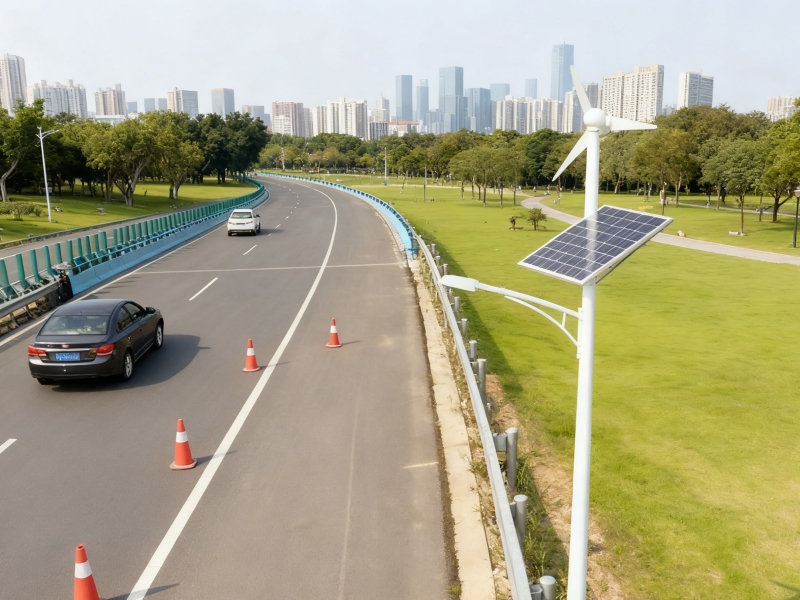Wind-solar hybrid street lights are a type of renewable energy street light that combines solar and wind power generation technologies with intelligent system control technology. Compared to other renewable energy sources, they may require more complex systems. Their basic configuration includes solar panels, wind turbines, controllers, batteries, light poles, and lamps. Although the required components are numerous, their operating principle is relatively straightforward.
Wind-solar hybrid street light work principle
A wind-solar hybrid power generation system converts wind and light energy into electrical energy. Wind turbines use natural wind as a power source. The rotor absorbs wind energy, causing the turbine to rotate and convert it into electrical energy. The AC power is rectified and stabilized by a controller, converted to DC power, which is then charged and stored in a battery bank. Utilizing the photovoltaic effect, solar energy is directly converted into DC power, which can be used by loads or stored in batteries for backup.
Wind-solar hybrid street light accessories
Solar cell modules, wind turbines, high-power solar LED lights, low-voltage power supply (LPS) lights, photovoltaic control systems, wind turbine control systems, maintenance-free solar cells, solar cell module brackets, wind turbine accessories, light poles, embedded modules, underground battery boxes, and other accessories.
1. Wind Turbine
Wind turbines convert natural wind energy into electricity and store it in batteries. They work in conjunction with solar panels to provide power for street lights. Wind turbine power varies depending on the power of the light source, generally ranging from 200W, 300W, 400W, and 600W. Output voltages also vary, including 12V, 24V, and 36V.
2. Solar Panels
The solar panel is the core component of a solar street light and also its most expensive. It converts solar radiation into electricity or stores it in batteries. Among the many types of solar cells, monocrystalline silicon solar cells are the most common and practical, offering more stable performance parameters and higher conversion efficiency.
3. Solar Controller
Regardless of the size of the solar lantern, a well-performing charge and discharge controller is crucial. To extend battery life, charge and discharge conditions must be controlled to prevent overcharging and deep charging. In areas with large temperature fluctuations, a qualified controller should also include temperature compensation. Furthermore, a solar controller should include streetlight control functions, including light control and timer control. It should also be able to automatically shut down the load at night, extending the operating time of streetlights on rainy days.
4. Battery
Because the input energy of solar photovoltaic power generation systems is extremely unstable, a battery system is often required to maintain operation. Battery capacity selection generally follows the following principles: First, while ensuring adequate nighttime lighting, the solar panels should store as much energy as possible while also being able to store enough energy to provide lighting during continuous rainy and cloudy nights. Undersized batteries will not meet nighttime lighting requirements. Oversized batteries will not only permanently deplete, shortening their lifespan, but also be wasteful. The battery should be matched to the solar cell and the load (streetlight). A simple method can be used to determine this relationship. The solar cell power must be at least four times the load power for the system to function properly. The voltage of the solar cell must exceed the operating voltage of the battery by 20-30% to ensure proper battery charging. The battery capacity should be at least six times the daily load consumption. We recommend gel batteries for their long lifespan and environmental friendliness.
5. Light Source
The light source used in solar street lights is a key indicator of their proper operation. Currently, LEDs are the most common light source.
LEDs offer a long lifespan of up to 50,000 hours, a low operating voltage, require no inverter, and offer high luminous efficiency.
6. Light Pole and Lamp Housing
The height of the light pole should be determined based on the road width, the spacing between lamps, and the road’s illumination standards.
TIANXIANG products utilize high-efficiency wind turbines and high-conversion solar panels for dual-energy complementary power generation. They can stably store energy even on cloudy or breezy days, ensuring continuous lighting. Lamps utilize high-brightness, long-life LED light sources, offering high luminous efficiency and low energy consumption. Lamp poles and core components are constructed from high-quality, corrosion-resistant, and wind-resistant steel and engineering materials, enabling them to adapt to extreme climates such as high temperatures, heavy rain, and severe cold in different regions, significantly extending product life.
Post time: Oct-14-2025

